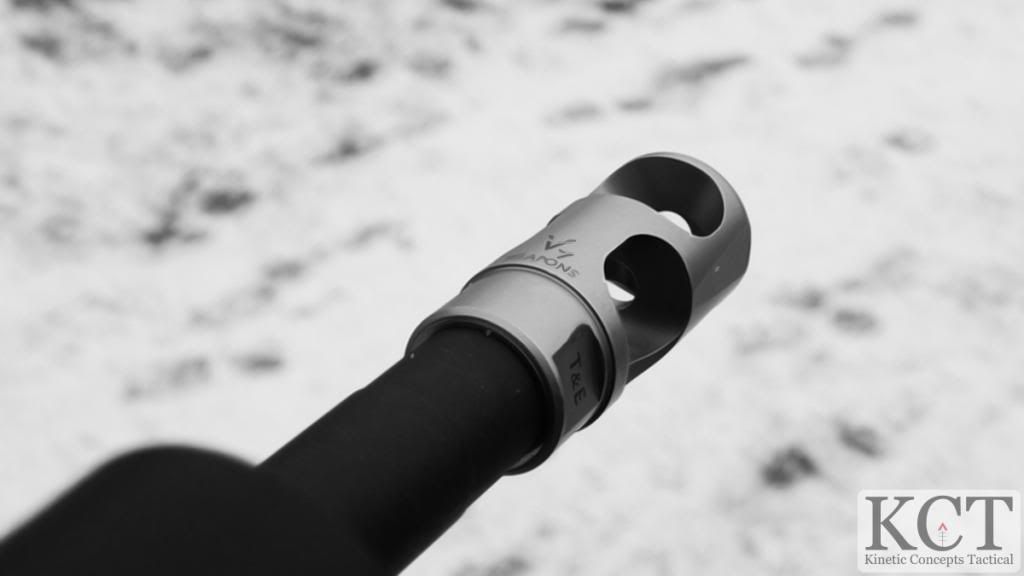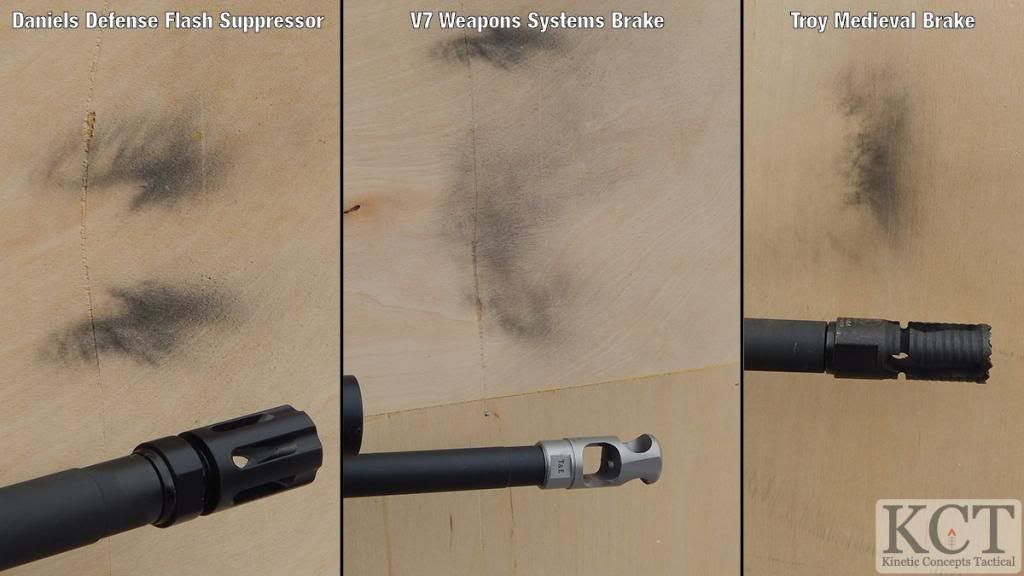Hit The Brakes
Muzzle brakes are tricky things. They act to tame the muzzle flip of the rifle and to reduce recoil, but often at the cost of excessive concussion, vicious muzzle blast, and in many cases a fireball at the muzzle that can ruin your night vision or give away your location. The best brakes tend to push one end of the envelope or the other, or seek to give the shooter the best compromise between recoil, muzzle flip, blast, and visual signature.
With such a complicated mix of factors affecting a brake's performance, it's no surprise that there many different designs on the market. V7 Weapons Systems steps into this market with a simplified design that holds a lot of surprises.
V7's Design
V7 decided to go with a specialized version of the horizontal port concept. This type of design can be seen in the Miculek and SureFire muzzle brake series. While the Miculek and SureFire designs feature minimal or non-existent top-side porting, the V7 brake sports an enlarged primary chamber directly in front of the end of the barrel with a massive port on each horizontal side and a smaller secondary chamber in front of the muzzle with slightly smaller vertical ports.
Both chambers feature large curved baffles which help direct propellant gasses upwards and slightly to the rear to counteract recoil. These baffles are interesting as they also served to catch the flash of the shot and stop it from being visible in front of the muzzle. The flash can be seen from behind and beside the shooter, but little flash makes it forward to the end of the brake.
Testing and Review
We took the V7 out on a snowy day and ran it alongside two other devices, the Daniel Defense Flash Suppressor and the Troy Medieval Muzzle Brake.
One of our first tests was to see how the brakes performed when shooting prone. The DD kicked up a moderate amount of the powdery snow, much more than anticipated for an A2 design. The Troy also had a decent amount of blast, shoveling a bit more snow than the DD. The V7... hardly moved any snow. So little snow we had to do it a few more times to make sure it wasn't a fluke. At one point, one of the testers asked if we were using the same 20-round mags he was, thinking maybe it was a 30-round magazine that was keeping the rifle off of the deck. We rapped off shots with 20-round Thermold and PMAGs, and the V7 featured exceptionally minimal dust/snow signature when shot in a conventional prone position.
Next, we positioned the brakes next to one of our shooting barricades and fired to pattern the muzzle blast, the results of which you can see below.
The DD flash hider produced distinct powder burns on the barrier above and below its central axis. The Troy produced a thick, dense blast pattern, while the V7 produced a thin cloud of powder residue. While this is far from a scientific test, you can clearly see that the powder patterns on the V7 are far less aggressive than the other devices. However, the V7 is more concussive as it is optimized as a brake. In terms of blast for shooters in either side, it was noticeably less than the SureFire design or the Primary Weapons Systems FSC 556 Brake.
Muzzle Climb
We used some high speed footage to capture the directions and distance of recoil with all three types of muzzle devices. These tests were performed while standing without supports to replicate the same mount of felt recoil and results as normal shooting. The Daniels Defense had a vertical jump with some rear-ward movement, and the Troy and V7 brakes both showed no vertical movement. Their travel paths backwards were very close, however the V7 had the least amount of movement.
Fire and Movement
In our preliminary testing, we ran several drills with the shooter moving down the shooting lane, engaging targets at the ringmaster's commands, and utilizing cover as it was presented to the shooter. The V7 handled very interesting in these tests. While it did not dissipate recoil as well as the FSC 556, it controlled muzzle flip incredibly well. It seemed to drive the rifle absolutely straight to the rear, much more so than the Troy. This made the shots very easy to time, as the shooters never had to fight the rifle back on to target, it simply stayed there. It also served extremely well in rapid fire. When a shooter was asked to stand and deliver on a target, they were able to deliver repeated strings of fire while keeping the rifle on target.
While shooting urban prone underneath a barricade, the V7 produced a decent blast which dug into the ground below the brake. While this flung up dirt and snow, it did not cause enough disturbance to cloud the shooter's vision, and despite being sideways it kept the rifle dead on target.
Initial Thoughts
The V7 brake is an excellent choice for those who want to control recoil while not going overboard with the concussive blast of most muzzle breaks. This brake is ideal for competitive and tactical shooters who demand precise control of their rifle during rapid strings of fire or who must deliver accurate shots while on the move.
Below we have a video from the various drills we ran while testing this brake out. Check it out and enjoy!
Click here to View the Range Day Video
You can see V7's entire line of components here.
Thank you for your interest in our article and site. Please take a moment to view the kydex holsters that we make, all at an extremely affordable price! Visit the store here: KCT Kydex Web Store
Thank you for your interest in our article and site. Please take a moment to view the kydex holsters that we make, all at an extremely affordable price! Visit the store here: KCT Kydex Web Store



No comments:
Post a Comment